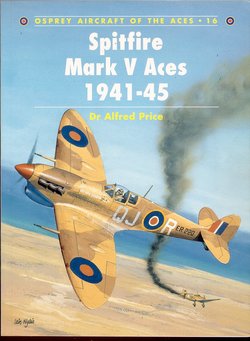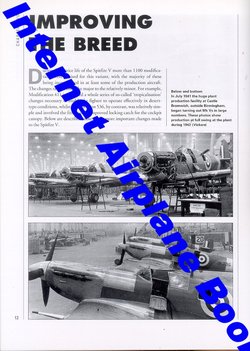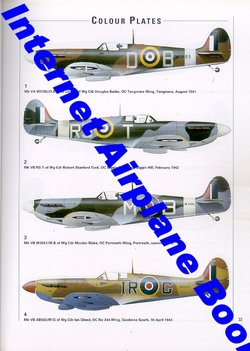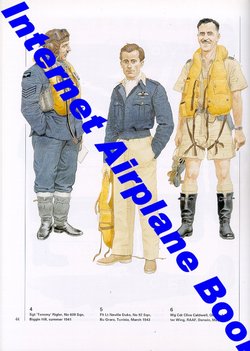OSPREY SPITFIRE MARK V ACES 1941 – 45 WW2 RAF FIGHTER
OSPREY AIRCRAFT OF THE ACES SERIES No.16
BY DR. ALFRED PRICE
COVER ARTWORK ILLUSTRATION BY IAIN WYLLIE, AIRCRAFT PROFILES BY JOHN WEAL, FIGURE ARTWORK BY MIKE CHAPPELL AND SCALE DRAWINGS BY MARK STYLING
APPROXIMATELY 100 PAGES SOFTBOUND JAM PACKED WITH HISTORICAL DETAILS, BIOGRAPHICAL SKETCHES OF THE MOST FAMOUS FIGHTER PILOTS AND THE FULL STORY BEHIND SOME OF THE MOST FAMOUS AND INCREDIBLE AERIAL DOG FIGHTS OF WW2.
INCLUDES APPROXIMATELY 60 COLOR PROFILES (INCLUDES AMONG OTHERS: WING COMMANDER DOUGLAS BADER, WING COMMANDER ROBERT STANFORD TUCK, IAN GLEED, CLIV CLADWELL, ALAN WRIGHT, GEORGE BEURLING, No.303 316 POLISH SQUADRON, RCAF CANADIAN No.401 411 SQUADRON, No. 485 NEW ZEALAND RNZAF SQUADRON )
TWO PAGES OF COLOR PLATES ILLUSTRATING FAMOUS WW2 FIGHTER ACES IN THEIR TYPICAL UNIFORMS: WING COMMANDER SAILOR MAHAN BIGGIN HILL, No.71 EAGLE SQUADRON, FL LT NEVILLE DUKE No.92 SQN, WING COMMANDER CLIVE CALDWELL RAAF AUSTRALIA
HUNDREDS OF BW WARTIME PHOTOGRAPHS.
SCALE THREE VIEW DRAWINGS
STOP GAP SPITFIRE VARIANT
IMPROVING THE BREED
IN ACTION OVER NORTH-WEST EUROPE
AIR BATTLE FOR MALTA
NORTH AFRICA WESTERN DESERT AIR FORCE BATTLES WITH THE LUFTWAFFE AFRIKA KORPS
SPITFIRE Vs FAR AND WIDE
TOP SPITFIRE MkV ACES
YOU WILL FIND GREAT DEALS ON HARD-TO-FIND AVIATION, ARMOR, NAUTICAL AND MILITARIA MAGAZINES AT MY EBAY STORE “INTERNET AIRPLANE MAGAZINES AND BOOKS”!
HTTP://STORES.EBAY.COM/INTERNET-AIRPLANE-MAGAZINES-BOOKS
I HAVE HUNDREDS OF ADDITIONAL LISTINGS USING THE SIMPLE “BUY-IT-NOW” FORMAT. I SPECIALIZE IN AVIATION REFERENCE MAGAZINES AND BOOKS. I ALSO CARRY TITLES ON MILITARY HISTORY, ARMOR, TANKS, SHIPS, ELITE SPECIAL UNITS AND AMERICAN CIVIL WAR. THESE ARE EXCELLENT GIFTS & REFERENCES FOR PILOTS, MILITARY AIRCREW, VETERANS, MILITARY RE-ENACTORS, SCALE MODELERS & AIRCRAFT ENTHUSIASTS. TITLES CURRENTLY LISTED INCLUDED: THE ELITE, TAKE OFF, WARPLANE, PROFILE PUBLICATIONS, AIRCRAFT ILLUSTRATED, AIRCRAFT ILLUSTRATED EXTRA, AIR COMBAT, AIR ENTHUSIAST, AMERICAN AIRMAN AND THE ILLUSTRATED ENCYCLOPEDIA OF AIRCRAFT.
HARD TO FIND GIFTS FOR SCALE MODELERS, PILOTS, AIRCREW & VETERANS
HERE'S AN INEXPENSIVE FATHER'S DAY GIFT, BIRTHDAY PRESENT OR CHRISTMAS PRESENT FOR THE VETERAN, REENACTOR, SCALE MODELER, MILITARIA ENTHUSIAST OR HISTORY CHANNEL LOVER IN YOUR FAMILY
MONEY BACK GUARANTEE!
YOU WILL LOVE MY CUSTOMER FRIENDLY RETURN POLICY. I WANT YOU OR YOUR GIFT RECIPIENT TO BE HAPPY WITH YOUR PURCHASE. I GUARANTEE THAT THE ITEM SHIPPED WILL BE AS DESCRIBED. YOU MAY RETURN THE ITEM WITHIN 14 DAYS FOR ANY REASON. JUST EMAIL ME AND RETURN POST THE PACKAGE ADEQUATELY PROTECTED AGAINST SHIPPING DAMAGE) AND I WILL RETURN YOUR ITEM PURCHASE PRICE IN FULL.
I WILL POST POSITIVE FEEDBACK FOR YOU AFTER THE TRANSACTION IS COMPLETE AND I AM REASONABLY SURE THAT YOU HAVE RECEIVED THE ITEM. IF THERE IS ANY PROBLEM, PLEASE EMAIL ME TO WORK THINGS OUT BEFORE LEAVING FEEDBACK. MY GOAL IS TO LEAVE EVERY CUSTOMER 100% SATISFIED WITH MY PRODUCTS AND SERVICE.
-----------------------------------------------------
----------------------------------------------------------------------------------------------------------------------------------
Additional
Information from Internet Encyclopedia
Spitfire
Mk V (Types 331, 349 & 352): Late in
1940, the RAF predicted that the advent of the pressurised Junkers Ju 86P
bomber series over Britain would be the start of a new sustained high altitude
bombing offensive by the Luftwaffe, in which case development was put in hand
for a pressurised version of the Spitfire, with a new version of the Merlin
(the Mk VI). It would take some time to develop the new fighter and an
emergency stop-gap measure was needed as soon as possible: this was the Mk V.
The
basic Mk V was a Mk I with the Merlin 45 series engine. This engine delivered
1,440 hp (1,074 kW) at take-off, and incorporated a new single-speed
single-stage supercharger design. Improvements to the carburettor also allowed
the Spitfire to use zero gravity manoeuvres without any problems with fuel
flow. Several Mk I and Mk II airframes were converted to Mk V standard by
Supermarine and started equipping fighter units from early 1941. The majority
of the Mk Vs were built at Castle Bromwich.
Three
versions of the Mk V were produced, with several sub-series:
Mk
VA (Type 331): The Spitfire Mk.VA
continued to use the Type A wing with 8 × .303" Brownings. This version
could reach a top speed of 375 mph (603 km/h) at 20,800 ft (6,300 m), and could
climb to 20,000 ft (6,100 m) in 7.1 minutes. A total of 94 were built. One well
known VA was W3185 D-B flown by Douglas Bader when commanding the Tangmere Wing
in 1941. He was shot down in this aircraft (possibly by friendly fire) during a
"Circus" (a wing of fighters escorting a small number of bombers)
over Northern France on 9 August 1941 and spent the rest of the war as a POW.
In April 1941 two Spitfire VAs R7347 and W3119 were sent to Wright Field,
Dayton, Ohio USA as sample aircraft. Both Spitfires were tested by NACA; one
series of tests included the fitting of special NACA "jet-propulsion"
exhaust stacks.
Mk
VB and VB(trop) (Type 349 and 352): The
VB became the main production version of the Mark Vs. Along with the new Merlin
45 series the B wing was fitted as standard. As production progressed changes
were incorporated, some of which became standard on all later Spitfires.
Production started with several Mk IBs which were converted to Mk VBs by
Supermarine. Starting in early 1941 the round section exhaust stacks were
changed to a "fishtail" type, marginally increasing exhaust thrust.
Some late production VBs and VCs were fitted with six shorter exhaust stacks
per side, similar to those of Spitfire IXs and Seafire IIIs; this was originally
stipulated as applying specifically to VB(trop)s. After some initial problems
with the original Mk I size oil coolers, a bigger oil cooler was fitted under
the port wing; this could be recognised by a deeper housing with a circular
entry. From mid-1941 alloy covered ailerons became a universal fitting.
A
constant flow of modifications were made as production progressed. A
"blown" cockpit hood, manufactured by Malcolm, was introduced in an
effort to further increase the pilot's head-room and visibility. Many mid to
late production VBs - and all VCs - used the modified, improved windscreen
assembly with the integral bullet resistant centre panel and flat side screens
introduced with the Mk III. Because the rear frame of this windscreen was
taller than that of the earlier model the cockpit hoods were not
interchangeable and could be distinguished by the wider rear framing on the
hood used with the late-style windscreen.
Different
propeller types were fitted, according to where the Spitfire V was built: Supermarine
and Westland manufactured VBs and VCs used 10 ft 9 in (3.28 m) diameter, 3
bladed de Havilland constant speed units, with narrow metal blades, while
Castle Bromwich manufactured VBs and VCs were fitted with a wide bladed Rotol
constant speed propeller of either 10 ft 9 in (3.28 m) diameter, with metal
blades, or (on late production Spitfires) 10 ft 3 in (3.12 m) diameter, with
broader, "Jablo" (compressed wood) blades. The Rotol spinners were
longer and more pointed than the de Havilland leading to a 3.5 in (8.9 cm)
increase in overall length. The Rotol propellers allowed a modest speed
increase over 20,000 ft (6,100 m) and an increase in the service ceiling. A
large number of Spitfire VBs were fitted with "gun heater
intensifier" systems on the exhaust stacks. These piped additional heated
air into the gun bays. There was a short tubular intake on the front of the
first stack and a narrow pipe led into the engine cowling from the rear
exhaust.
The
VB series were the first Spitfires able to carry a range of specially designed
"slipper" drop tanks which were fitted underneath the wing
centre-section. Small hooks were fitted, just forward of the inboard flaps:
when the tank was released these hooks caught the trailing edge of the tank,
swinging it clear of the fuselage.
With
the advent of the superb Focke Wulf Fw 190 in August 1941 the Spitfire was for
the first time truly outclassed, hastening the development of the
"interim" Mk IX. In an effort to counter this threat, especially at
lower altitudes, the VB was the first production version of the Spitfire to use
"clipped" wingtips as an option, reducing the wingspan to 32 ft 2 in
(9.8 m).The clipped wings increased the roll rate and airspeed at lower
altitudes. Several different versions of the Merlin 45/50 family were used,
including the Merlin 45M which had a smaller "cropped" supercharger
impeller and boost increased to +18 lb. This engine produced 1,585 hp (1,182
kW) at 2,750 ft (838 m), increasing the L.F VB's maximum rate of climb to 4720
ft/min (21.6 m/s) at 2,000 ft (610 m).
The
Mk VB(trop) (or type 352) could be identified by the large Vokes air filter
fitted under the nose; the reduced speed of the air to the supercharger had a
detrimental effect on the performance of the aircraft, reducing the top speed
by 8 mph (13 km/h) and the climb rate by 600 ft/min (3.04 m/s), but the
decreased performance was considered acceptable. This variant was also fitted
with a larger oil tank and desert survival gear behind the pilot's seat. A new
"desert" camouflage scheme was applied. Many VB(trop)s were modified
by 103 MU (Maintenance Unit-RAF depots in which factory fresh aircraft were
brought up to service standards before being delivered to squadrons) at Aboukir,
Egypt by replacing the Vokes filter with locally manufactured
"Aboukir" filters, which were lighter and more streamlined. Two
designs of these filters can be identified in photos: one had a bulky, squared
off filter housing while the other was more streamlined. These aircraft were
usually fitted with the wide blade Rotol propeller and clipped wings.
Mk
Vc and V (trop) (types 349 and 352/6): As well as having most of the standard
Mk V features this version had several important changes over the earlier Mk V,
most of which were first tested on the Mk III. These included the re-stressed
and strengthened fuselage structure and the new windscreen design, which was
also used on some Vb Spitfires. The Vc also introduced the Type C or
"Universal" wing along with the revised main undercarriage; the tops
of these wings featured large, bulged fairings to provide clearance for the
ammunition feed motors of two Hispano cannon. Later, because two cannon were
seldom fitted, these fairings were later reduced in size to more streamlined
shapes. A deeper radiator fairing was fitted under the starboard wing and a
larger oil cooler with a deeper, kinked air outlet was fitted underneath the
port wing. In addition more armour plating was added, protecting the bottom of
the pilot's seat and the wing ammunition boxes.
The
first Spitfire to be sent overseas in large numbers was the Mk Vc (trop). The
majority of these were used by Allied squadrons in the Mediterranean theatre
(including North Africa), Burma and in Australia with No. 1 Fighter Wing RAAF.
The Vc initially suffered a high rate of mechanical failure in Australia, due
to corrosion in engine cooling pipes that were unfilled and exposed to salt
air, while being shipped from the UK.
A
total of 300 Mk VC(trop)s were shipped to Australia for the RAAF; the first of
these arrived in late 1942. A total of 143 Spitfire VB (including Mk II
conversions) were supplied to Soviet Union. Portugal was the recipient of two
lots of Spitfire VBs; 33 refurbished ex-RAF aircraft started arriving in early
1944 and a further and final shipment of 60 mainly clipped wing L.F Mk VBs
arrived in 1947. All were retrofitted with TR 9 HF radios and had no IFF. The
last of these Spitfires were taken out of service in 1952. Twelve were
delivered to Royal Egyptian Air Force.
In
1944 enough Spitfire VB (trop)s to equip one squadron were supplied to Turkey.
Some were later fitted with the larger, pointed rudder developed for later
Merlin-powered Spitfires. These flew alongside of the Focke-Wulf Fw 190A-3s
which had been supplied to Turkey by Germany.
In
total, production was 6,479, consisting of 94 Mk VA, built by Supermarine,
3,911 Mk VB, (776 by Supermarine, 2,995 Castle Bromwich and 140 Westland) and
2,467 Mk VC, (478 Supermarine, 1,494 Castle Bromwich, 495 Westland) plus 15 PR
Type F by Castle Bromwich.














